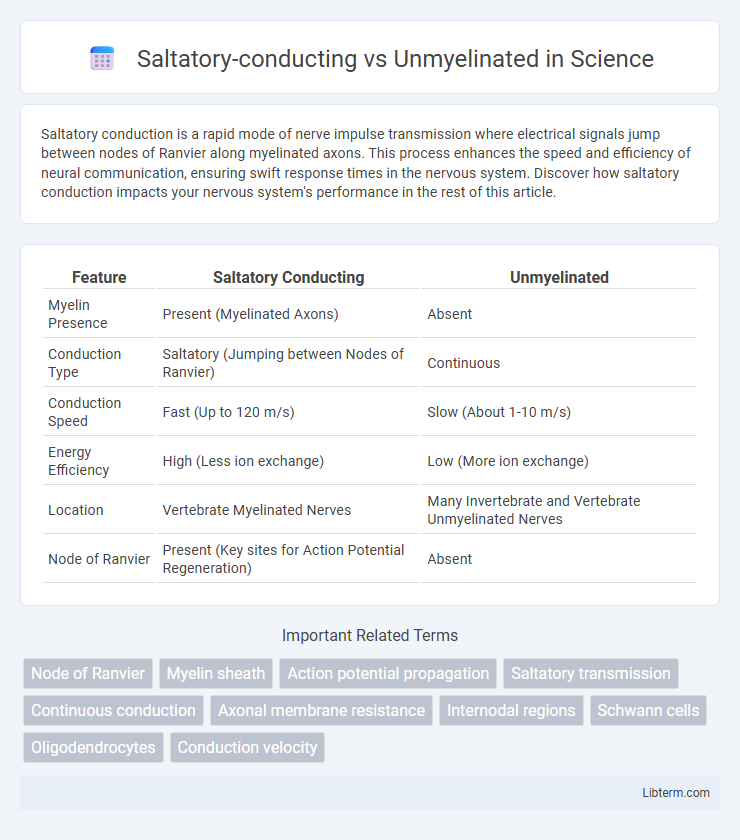Saltatory conduction is a rapid mode of nerve impulse transmission where electrical signals jump between nodes of Ranvier along myelinated axons. This process enhances the speed and efficiency of neural communication, ensuring swift response times in the nervous system. Discover how saltatory conduction impacts your nervous system's performance in the rest of this article.
Table of Comparison
| Feature | Saltatory Conducting | Unmyelinated |
|---|---|---|
| Myelin Presence | Present (Myelinated Axons) | Absent |
| Conduction Type | Saltatory (Jumping between Nodes of Ranvier) | Continuous |
| Conduction Speed | Fast (Up to 120 m/s) | Slow (About 1-10 m/s) |
| Energy Efficiency | High (Less ion exchange) | Low (More ion exchange) |
| Location | Vertebrate Myelinated Nerves | Many Invertebrate and Vertebrate Unmyelinated Nerves |
| Node of Ranvier | Present (Key sites for Action Potential Regeneration) | Absent |
Introduction to Nerve Conduction
Saltatory conduction occurs in myelinated nerve fibers, where electrical impulses jump between nodes of Ranvier, significantly increasing conduction velocity. In contrast, unmyelinated fibers propagate impulses through continuous conduction along the entire axon, resulting in slower signal transmission. This fundamental difference in nerve conduction mechanisms underpins varying functional responses in the nervous system.
Anatomy of Myelinated vs Unmyelinated Fibers
Myelinated fibers feature axons wrapped in multiple layers of myelin sheath formed by Schwann cells or oligodendrocytes, enabling saltatory conduction through nodes of Ranvier that accelerate nerve impulse transmission. Unmyelinated fibers lack this organized myelin sheath, resulting in continuous conduction and significantly slower signal propagation. The structural presence of myelin in myelinated fibers is crucial for rapid electrical insulation and efficient neural communication compared to unmyelinated fibers.
Mechanism of Saltatory Conduction
Saltatory conduction occurs in myelinated nerve fibers where action potentials jump between nodes of Ranvier, significantly increasing conduction velocity by reducing ion channel activation along the axon. This mechanism relies on the insulation provided by the myelin sheath, which prevents ion leakage and concentrates depolarization events at the nodes. In contrast, unmyelinated fibers propagate action potentials continuously along the entire axon membrane, resulting in slower signal transmission due to a uniform opening of voltage-gated ion channels.
Action Potential Propagation in Unmyelinated Axons
Action potential propagation in unmyelinated axons occurs through continuous conduction, where the electrical impulse moves sequentially along each segment of the axonal membrane. This process is slower compared to saltatory conduction in myelinated fibers because the depolarization must actively regenerate at every point along the axon without the insulating advantage of myelin sheaths. The absence of myelin leads to increased ion leakage and greater energy expenditure for maintaining the action potential, resulting in reduced conduction velocity.
Speed Comparison: Saltatory vs Continuous Conduction
Saltatory conduction in myelinated axons enables nerve impulses to jump between nodes of Ranvier, significantly increasing transmission speed compared to continuous conduction in unmyelinated fibers, where the impulse travels along every segment of the membrane. The velocity of saltatory conduction can be up to 50-100 meters per second, whereas continuous conduction typically ranges from 0.5 to 10 meters per second in smaller, unmyelinated neurons. This speed difference optimizes rapid signal transmission in complex nervous systems, enhancing reflexes and coordinated muscle movements.
Energy Efficiency in Nerve Transmission
Saltatory conduction in myelinated axons significantly enhances energy efficiency by allowing action potentials to jump between nodes of Ranvier, reducing the need for continuous ion exchange along the entire axon membrane. In contrast, unmyelinated axons require continuous depolarization, resulting in greater ATP consumption by sodium-potassium pumps to restore ion gradients. This fundamental difference in conduction mechanism explains why saltatory conduction is energetically advantageous in rapid and long-distance nerve signal transmission.
Physiological Roles of Myelinated and Unmyelinated Fibers
Myelinated fibers enable rapid saltatory conduction by allowing action potentials to jump between nodes of Ranvier, significantly increasing nerve signal transmission speed and efficiency. Unmyelinated fibers propagate impulses through continuous conduction, supporting slower, sustained signals essential for autonomic functions such as pain and temperature sensation. The physiological roles of myelinated fibers emphasize high-speed communication for motor control and sensory precision, whereas unmyelinated fibers maintain fundamental regulatory processes within the autonomic nervous system.
Clinical Implications of Axon Myelination
Saltatory conduction in myelinated axons enables rapid signal transmission by allowing electrical impulses to jump between nodes of Ranvier, significantly enhancing neural efficiency compared to the slower, continuous conduction in unmyelinated fibers. Clinically, demyelinating diseases such as multiple sclerosis disrupt saltatory conduction, leading to impaired motor and sensory functions due to reduced nerve conduction velocity and signal fidelity. Understanding the differences between myelinated and unmyelinated axons is crucial for developing treatments targeting remyelination and neuroprotection in peripheral neuropathies and central nervous system disorders.
Disorders Affecting Myelination and Nerve Function
Saltatory conduction occurs in myelinated neurons, allowing rapid signal transmission by jumping between nodes of Ranvier, whereas unmyelinated fibers conduct impulses more slowly through continuous propagation. Disorders like Multiple Sclerosis (MS) and Charcot-Marie-Tooth disease degrade myelin sheaths, disrupting saltatory conduction and leading to impaired nerve function, muscle weakness, and sensory deficits. Demyelination reduces conduction velocity and can cause neurodegeneration, highlighting the critical role of myelin integrity in maintaining efficient neural communication.
Future Perspectives in Nerve Conduction Research
Saltatory conduction, characterized by rapid signal transmission along myelinated axons, presents significant advantages over unmyelinated nerve conduction, which relies on slower, continuous signal propagation. Future research in nerve conduction emphasizes enhancing myelin regeneration and exploring synthetic myelin analogs to improve neurological recovery and treatment of demyelinating diseases like multiple sclerosis. Advances in nanotechnology and molecular biology aim to optimize ion channel distribution and improve the efficiency of saltatory conduction, potentially transforming therapies for peripheral neuropathies and central nervous system injuries.
Saltatory-conducting Infographic

 libterm.com
libterm.com